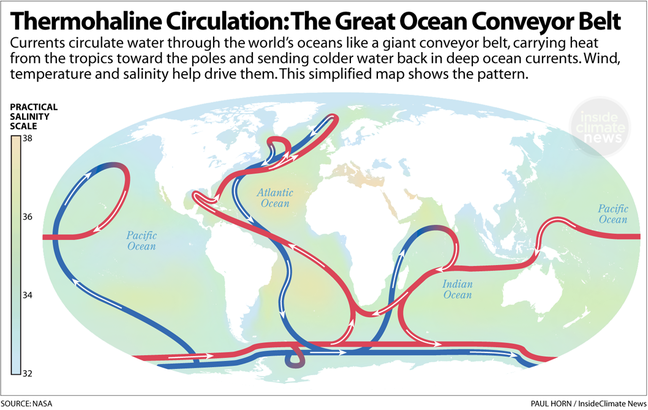Thermohaline circulation, often referred to as the global conveyor belt, is an intricate system of ocean currents driven by variations in temperature and salinity. This mechanism plays a quintessential role in regulating the Earth’s climate by distributing heat, nutrients, and gases throughout the world’s oceans. In a rapidly changing environment, understanding this circulation becomes imperative. It promises to reshape our perspective on climate change and highlights the interconnectedness of global systems.
At its core, thermohaline circulation is initiated in the polar regions, where cold, salty water sinks and sets the stage for a deep oceanic flow. This denser water cascades deep into the ocean’s abyss, creating a network of currents that traverse the globe. The interplay of heat and salinity acts like a natural thermostat, influencing not just marine ecosystems but also driving atmospheric patterns that impact weather and climate.
The ocean’s surface is primarily warmed by the sun, creating a warm, buoyant layer that floats atop the colder, denser waters below. When the surface water cools—particularly in the North Atlantic and Antarctic regions—it becomes denser and begins to sink. This sinking process is crucial, as it initiates the long journey of thermohaline circulation, connecting the world’s oceans. As water moves from the equator to the poles, it undergoes changes in both temperature and salinity, influencing its density and thus the movement of water masses.
This circulation system is characterized by its vast scale. Water parcels can travel thousands of kilometers. The journey can take centuries, and in doing so, these water masses engage with the ocean floor, facilitating the transfer of nutrients essential for marine life. This mechanism is not only vital for sustaining marine biodiversity, but it also plays a pivotal role in carbon sequestration. The deep ocean acts as a significant reservoir of carbon dioxide, mitigating the effects of climate change by storing greenhouse gases that would otherwise accumulate in the atmosphere.
However, this delicate equilibrium is increasingly threatened by climate change. As global temperatures rise, the polar regions are experiencing unprecedented warming, leading to alterations in the density of seawater. Melting ice sheets release freshwater into the ocean, reducing salinity in key areas of thermohaline circulation. This process disrupts the downwelling currents that fuel this system, potentially leading to a slowdown of the global conveyor belt.
A slowdown in thermohaline circulation carries with it cascading consequences. One of the most alarming is the potential for significant climate shifts. Changes in ocean currents can influence weather patterns across the globe, altering monsoon cycles, intensifying storms, and affecting agriculture. For instance, regions like Western Europe may find themselves facing colder climates if the North Atlantic Current weakens, while other regions may experience increased flooding and drought.
Additionally, the ecosystems dependent on stable ocean currents would face irrevocable changes. The distribution of marine species, many of which are sensitive to temperature changes, would be affected. Coral reefs, which rely on specific thermal and salinity conditions, may be particularly vulnerable, with biodiversity at risk. This scenario emphasizes the importance of preserving marine habitats and maintaining the health of ocean systems, as they are integrally linked to the planet’s climate.
There exists a critical need for increased monitoring and research into thermohaline circulation. Understanding the nuances of this system is vital for making informed decisions regarding climate policy and conservation efforts. Oceanographers are utilizing sophisticated technologies—such as satellite remote sensing and autonomous underwater vehicles—to track changes in salinity and temperature. These innovations promise to enhance our comprehension of how thermohaline circulation is changing and predict future shifts in climate patterns.
Investing in marine research initiatives is crucial. The more data collected about this circulation, the better equipped scientists will be to predict its future, and subsequently, its effects on climate. Collaborative efforts among countries could lead to groundbreaking discoveries that might not only enhance our understanding of oceanic systems but also foster international cooperation to combat climate change.
The implications of thermohaline circulation transcend scientific boundaries, touching upon economic, social, and political spheres. Fishing industries, which rely heavily on stable ocean ecosystems, can be profoundly affected by changes in circulation. Consequently, livelihoods and food security for millions of people may hang in the balance. Social constructs are, in many cases, intertwined with the health of marine environments, making climate action an imperative that encompasses a multitude of sectors.
In conclusion, thermohaline circulation is a powerful yet vulnerable component of the Earth’s climate system. The course of our future is intertwined with the health of our oceans. Recognizing the threats posed by anthropogenic climate change offers an opportunity to reconsider our relationship with the environment. The ocean is not merely a backdrop to our lives; it is a dynamic entity that warrants respect and protection. Understanding thermohaline circulation forces us to reflect on our contributions to the climate crisis and motivates us to take action.
As changes unfold, it is imperative that we cultivate a sense of stewardship toward our oceans. The urgency of the moment calls for collective action, innovative solutions, and a profound respect for the interconnectedness of all systems on Earth. Ultimately, by reevaluating our approach to thermohaline circulation and the ocean, we can foster not only awareness but also a commitment to safeguarding our planet for future generations.






